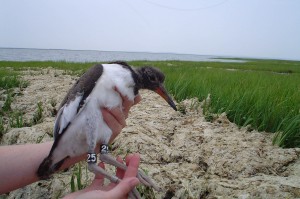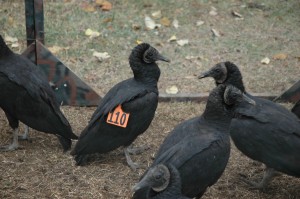CCB Bulletin to Birders: Request for assistance in locating marked birds
United States Nightjar Survey Network expands
October 17, 2008Osprey and menhaden in Chesapeake Bay
January 1, 2009
Written by Bryan Watts & Elizabeth Mojica
October 18, 2008

Strings of alpha-numeric peregrine falcon color identification bands. Each peregrine banded in Virginia gets a bi-color band with a unique code. Photo by Bryan Watts.
Over the past several years, the Center for Conservation Biology has initiated several long-term studies of various species using field-readable markers. Unlike conventional metal bands that require a bird to be recaptured in order to be identified, these markers may be read in the field with binoculars or spotting scopes. For these species, bald eagles, peregrine falcons, American oystercatchers, black vultures, CCB requests all individuals encountering marked birds to report the following:
1. Species and condition of bird
2. Location and position of marker
(leg or wing, left or right, above or below joint)
3. Color of marker
4. Code on marker
5. Date of observation
6. Location of observation
Bald Eagles

Purple alpha-numeric band on the left leg (top) and aluminum USFWS band on the right leg (bottom) of a bald eagle chick banded in Maryland in 2008. Photo by Bryan Watts.
In 2007, CCB began using alpha-numeric bands in addition to USGS metal bands on both nestlings and free-flying bald eagles in Virginia and Maryland. The bands are purple with engraved numbers/letters. The code is repeated 3 times around the band. Several other states are also actively banding eagles with other band colors and codes, so it is important to observe the band color. If you observe a bald eagle with an alpha-numeric band please report the observation to:
CCB
757-221-1645
info@ccbbirds.org
Peregrine Falcons
 For more than 20 years, peregrine falcons hatched in Virginia have been marked with field-readable bands. Over the years, there has been 3 generations of bands that differ in color and coding. Most states in the eastern United States are also using field-readable bands with the same color scheme, but each individual bird has its own unique code. It is important to note the band color or colors and the actual code. If you observe a peregrine falcon with an alpha-numeric band please report the observation to:
For more than 20 years, peregrine falcons hatched in Virginia have been marked with field-readable bands. Over the years, there has been 3 generations of bands that differ in color and coding. Most states in the eastern United States are also using field-readable bands with the same color scheme, but each individual bird has its own unique code. It is important to note the band color or colors and the actual code. If you observe a peregrine falcon with an alpha-numeric band please report the observation to:CCB
757-221-1645
info@ccbbirds.org
American Oystercatchers

Banded American oystercatcher chick, Virginia’s barrier islands. Photo by Alex Wilke.
Since 2004, hatchling American oystercatchers have been marked with field-readable bands on the Eastern Shore of Virginia. Birds have been double banded with identical, coded bands on both legs above the joint. The code is repeated 3 times around the band. We are using black bands with white codes. Several states along the Atlantic coast are also banding oystercatchers, but with different color bands so it is important to determine band color.
If you observe an American oystercatcher with an alpha-numeric band please report the observation to:
Alexandra Wilke
757-442-3049
awilke (at) tnc.org
Black Vultures

A black vulture with a numbered wing-tag. Photo by Ray Fernald/VDGIF.
In the fall of 2007, The Center for Conservation Biology (CCB) marked 100 black vultures with patagial tags (wing tags). Each bird was double tagged with identical markers on each wing. The tags are orange with 3 black numbers. White tags with black characters have also been used briefly in Virginia and further south. If you observe a black vulture with a patagial marker please report the observation to CCB staff:
CCB
757-221-1645
info@ccbbirds.org
Related posts
October 8, 2025
October 8, 2025
October 8, 2025



